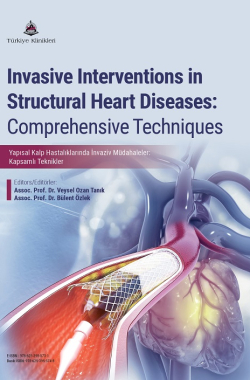MITRAL PARAVALVULAR LEAK CLOSURE
Salim Yaşar
Gülhane Training and Research Hospital, Department of Cardiology, Ankara, Türkiye
Yaşar S. Mitral Paravalvular Leak Closure. In: Tanık VO, Özlek B, editors. Invasive Interventions in Structural Heart Diseases: Comprehensive Techniques. 1st ed. Ankara: Türkiye Klinikleri; 2025. p.139-150.
ABSTRACT
Transcatheter closure of mitral paravalvular leak (PVL) is increasingly recognized as a significant alternative to redo surgery for patients experiencing heart failure or severe hemolysis due to PVL following prosthetic valve replacement. As life expectancy increases and the number of percutaneous or surgical valve replacement operations rises, the likelihood of paravalvular leakages will also increase accordingly. But especially in patients with high surgical risk, symptomatic, persistent hemolysis, and advanced PVL, if anatomical suitability is also present, the transcatheter closure of PVL is recommended with a Class IIa indication in both the ESC 2021 and the 2020 AHA/ACC Valve Disease Guidelines. In the closure of mitral paravalvular leaks, three different transcatheter methods are used: antegrade transseptal, retrograde transfemoral and transapical. Which method will be preferred primarily depends on the operator’s experience, the localization of the defect, the presence of an accompanying metallic aortic prosthetic valve, or the presence of peripheral artery disease that could hinder transaortic passage are important factors in determining the choice of methods used to cross and close the defect. The transcatheter closure of the mitral PVL is one of the most difficult structural heart interventions because it requires a lot of complicated imaging and catheter techniques. The success of the procedure depends on patient factors, anatomical factors, and the experience and expertise of the center performing the procedure. Experienced centers can perform transcatheter mitral PVL closure procedures quite safely and with acceptable complication rates. For the closure of mitral PVL, 3D TEE (transesophageal echocardiography) imaging is essential both in the pre-procedural assessment and during the procedure. The assessment and monitoring of patients by a multidisciplinary team comprising an interventional cardiologist, echocardiography expert, cardiovascular surgeon, and anesthesiologist, along with rapid detection and management of potential complications during and post-procedure, are critical factors that enhance the overall success of the intervention. Over time, accumulated experience has allowed for the development of creative strategies to overcome technical challenges. Larger studies and special devices are required to develop these procedures.
Keywords: Valvular prosthesis; Mitral paravalvular leak; Percutaneous closure; 3D echocardiography
Kaynak Göster
Referanslar
- Desai A, Messenger JC, Quaife R, Carroll J. Update in Paravalvular Leak Closure. Curr Cardiol Rep. 2021;23(9):122. [Crossref] [PubMed]
- Karaüzüm İ, Kılıç T. Transkateter yöntemle mitral paravalvüler kaçak kapatılması: Teknik bilgiler. Türkiye Klinikleri. 2020;1:27-33. [Link]
- Lazaro C, Hinojar R, Zamorano JL. Cardiac imaging in prosthetic paravalvular leaks. Cardiovasc Diagn Ther. 2014;4(4):307-313. [Crossref]
- Kilic T, SahinT, Ural E. Percutaneous retrograde transfemoral closure of mitral paravalvular leak in 3 patients without construction of an arteriovenous wire loop. Tex heart Inst J. 2014;41(2):170-3:170. [Crossref] [PubMed] [PMC]
- Jelnin v DY, Einhorn Bn, Kronzon I, Cohen hA, Ruiz CE.. Clinical experience with percutaneous left ventricular transapical access for interventions in structural heart defects a safe access and secure exit. JACC Cardiovasc Interv. 2011;4:868-874. [Crossref] [PubMed]
- Hourihan M PS, Mandell VS, et al. . Transcatheter umbrella closure of valvular and paravalvular leaks. . J Am Coll Cardiol. 1992;20(6):1371-1377. [Crossref] [PubMed]
- Kim Ms CI, garcia JA, et al. Percutaneous transcatheter closure of prosthetic mitral paravalvular leaks: are we there yet?. JACC Cardiovasc Interv. 2009;2:81-90. [Crossref] [PubMed]
- García E SJ, Unzue L, et al. Paravalvular leaks: mechanisms, diagnosis and management. EuroIntervention. 2012;8:41-52. [Crossref] [PubMed]
- García E H-AR, Dutary J, et al. Técnicas de rápido desarrollo en intervencionismo estructural [Rapidly evolving techniques for structural heart disease interventions]. Rev Esp Cardiol. 2011;64 Suppl 2:19-27. [Crossref] [PubMed]
- Kalogeras K, Ntalekou K, Aggeli K, Moldovan C, Katsianos E, Kalantzis C, et al. Transcatheter closure of paravalvular leak: Multicenter experience and follow-up. Hellenic J Cardiol. 2021;62(6):416-422. [Crossref] [PubMed]
- Ruiz CE, Hahn RT, Berrebi A, Borer JS, Cutlip DE, Fontana G, et al. Paravalvular Leak Academic Research C. Clinical Trial Principles and Endpoint Definitions for Paravalvular Leaks in Surgical Prosthesis. Eur Heart J. 2018;39(15):1224-1245. [Crossref] [PubMed]
- Ruiz CE, Jelnin V, Kronzon I, Dudiy Y, Del Valle-Fernandez R, Einhorn BN, et al. Clinical outcomes in patients undergoing percutaneous closure of periprosthetic paravalvular leaks. J Am Coll Cardiol. 2011;58(21):2210-2217. [Crossref] [PubMed]
- Sorajja P, Cabalka AK, Hagler DJ, Rihal CS. Percutaneous repair of paravalvular prosthetic regurgitation: acute and 30-day outcomes in 115 patients. Circ Cardiovasc Interv. 2011;4(4):314-321. [Crossref] [PubMed]
- Jenab Y, Nourian S, Hosseini Mohammadi NS, Mohseni-Badalabadi R, Hosseini K, Zakavi S, et al. Complications of transcatheter paravalvular leak device closure of mitral valve: An updated review of the literature and a rare case presentation. Clin Cardiol. 2024;47(5):e24272. [Crossref] [PubMed] [PMC]

